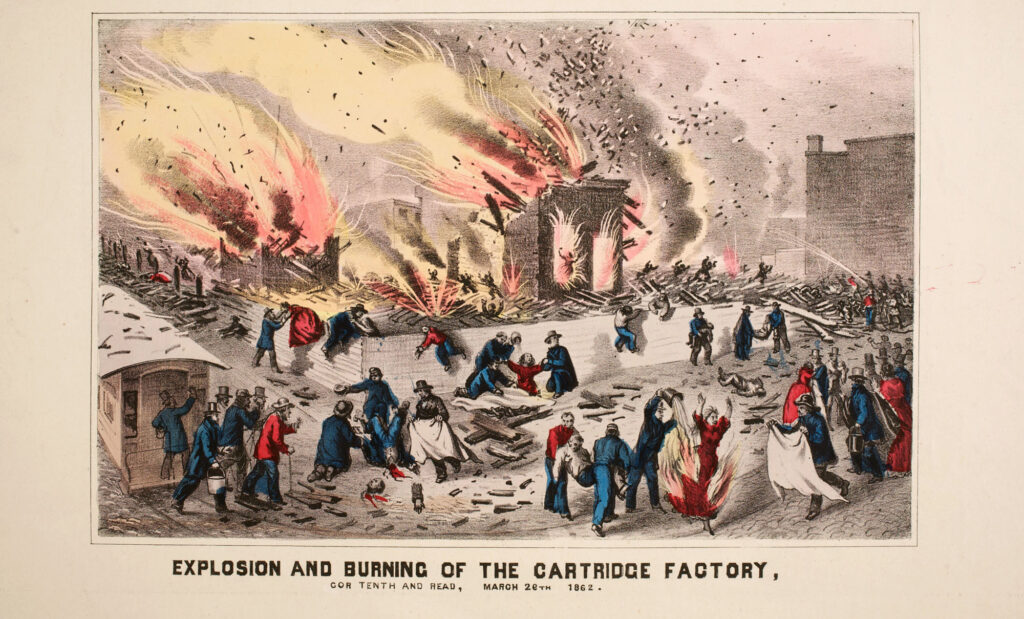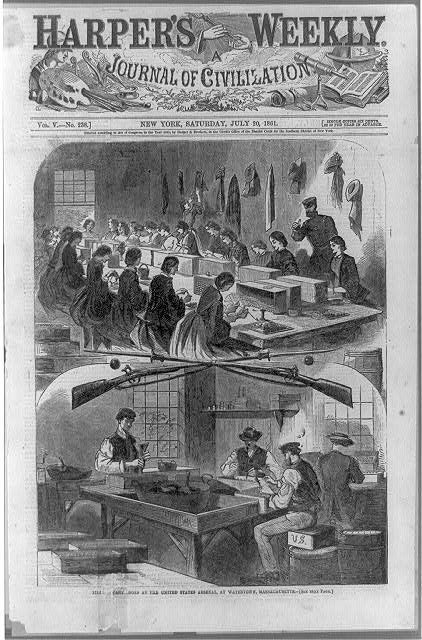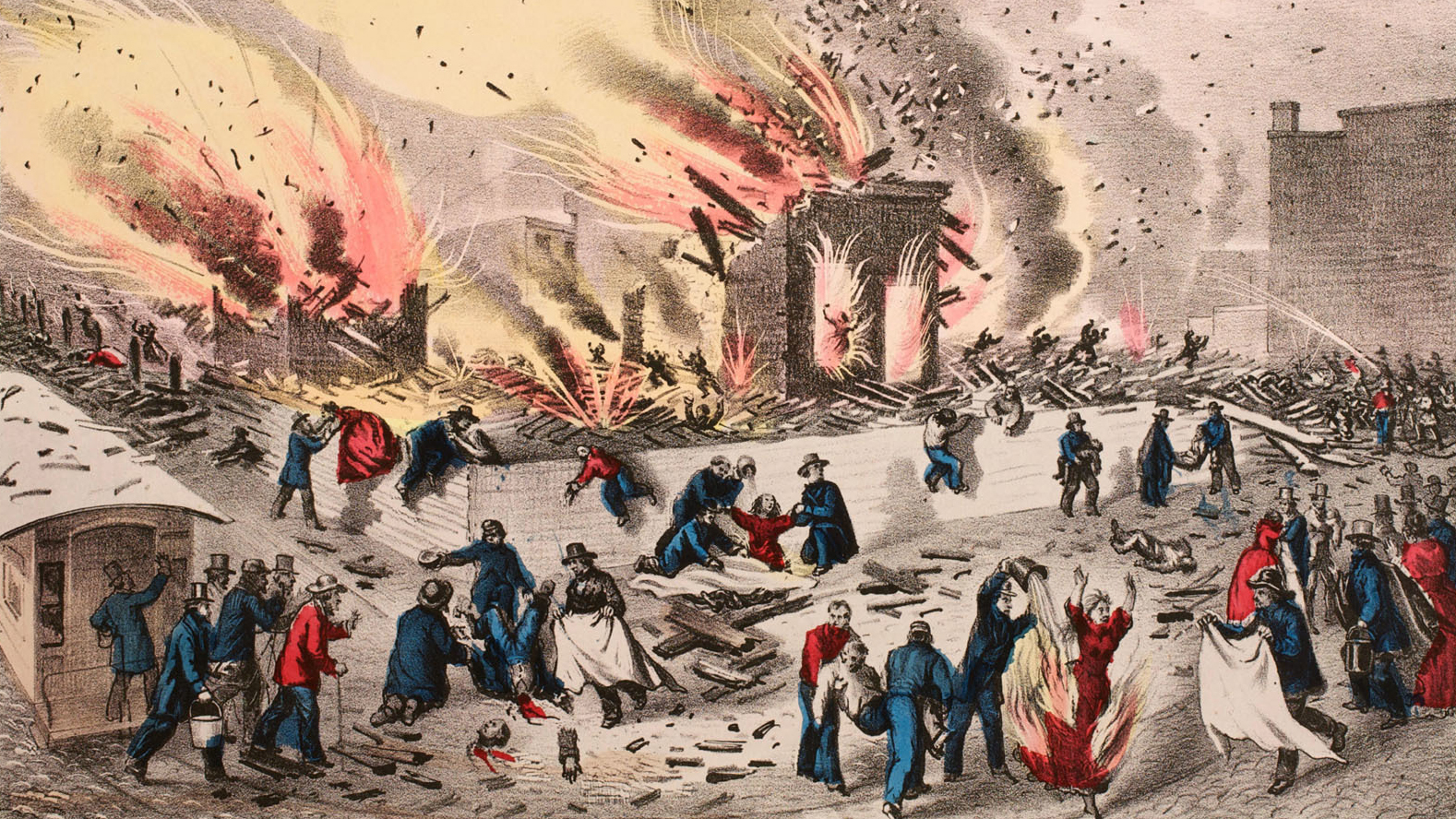While researching episodes for the podcast, I am constantly tempted down rabbit holes, chasing after fascinating fragments of history. Recently, I was struck by this image from the Library Company of Philadelphia, which shows a munitions factory explosion at 10th and Reed Streets in March 1862. It was the figures of women in flames that seemed particularly horrible. These women were doing dangerous work for the war effort. What drove them to take such risks?

Making Experimental Munitions
The munitions factory was making experimental “solid waterproof patent cartridges” for the Union war effort. The factory at 10th and Reed was trying out an entirely new manufacturing process, which took the already extremely risky process of filling cartridges with gunpowder, and added a volatile liquid to the mix.
- The patent cartridges were made by first creating a putty from a mix of 1) meal powder, the fine dust left behind after sieving and grading gunpowder; 2) rifle powder, slightly coarser than meal powder; 3) and collodion, a highly flammable liquid made from nitrocellulose, better known as guncotton, suspended in ether and alcohol.
- The putty was compressed into brass molds using light mallets. This work was done by the boys in the moulding room.
- Once the putty had dried, the dried gunpowder plugs were removed from the molds and taken to another room, which was heated with a stove. Here, the girls placed the dried gunpowder plugs into paper tubes, topped them with the lead bullets, and tied the whole cartridge up in ribbon.
- In a separate varnish room, also heated with a stove, the paper cartridges were then brushed with a coating of collodion.
- Finally, the cartridges were transferred to the greasing room to be coated with a final layer of beeswax and tallow, which was kept liquid by being heated by a spirit lamp, before being packed up in bundles.

The Explosion
The factory at 10th and Reed was owned by “Professor” Samuel Jackson, well-known in Philadelphia for his fireworks. He’d been inventing and making fireworks since 1837 and this fire was just one of many in his 50-year career. This fire was particularly devastating for Jackson. Fifteen people were killed in this explosion in 1862, and this included his 23-year-old son, Edwin. Most of the factory’s 78 workers were teenage boys, girls, and women.
The fire started in the moulding room. Jackson saw smoke coming from this room seconds before the first explosion. Then the room where the women were wrapping the cartridges caught on fire. After this, the second and most devastating explosion was caused by the fire spreading to the magazine where the gunpowder was stored in an underground structure. This was the blast that knocked people off their feet, blew out windows and doors, and damaged brick walls nearby. A third explosion came from the office, where Jackson, supposedly called “Old Careful,” had a few rockets sitting out.
At the inquest, Jackson testified that “the whole atmosphere of the [moulding] room was filled with the vapor of collodion” and that “everything was in confusion incident to a new business.” Jackson thought that the heat caused by the iron mallets striking the brass molds might have created enough heat to set off the gunpowder-collodion putty. This seemed to be confirmed by another employee. One man, severely burned in his front above the waist, worried that he caused the accident. He’d been filling the molds when he saw a flash followed by an explosion. He died a few days later (“Late Intelligence,” Philadelphia Inquirer, April 5,1862).
Women’s War Work
Many contemporaries were horrified, just as I was, with the presence of women and girls in these dangerous factories where they were engaging in war work. Dr. Judith Giesberg’s book Army at Home explores the unease that many felt about women taking on men’s work in a time of war. What kind of country were they fighting for anyway? Work outside the home was supposed to be reserved for respectable, working class men who took care of their families. Though the reality had always been that working-class wives and mothers had to take on work of their own to keep their families fed and clothed. However, this women’s work had typically been invisible, taking place in a home somewhere, even if it wasn’t their own.
During the war, often both women and children of the family needed to find work. If the men of the family were serving in the Union Army, their pay was not doled out in a reliable way. Families couldn’t be sure when the next pay packet would arrive. On top of that, inflation in the north was around 80% during the war years. So even when the pay did arrive, it was worth less and less.
Filling cartridges was a high paying job, paying much more than a woman could get doing piecework (sewing pre-cut fabric into garments at home) or working in a textile factory. It was typical for extended families to work at the same munitions factory, using their connections to get everyone a good job. This was certainly true at Jackson’s munitions factory. In addition to his son, Jackson had two daughters working at the factory who were badly burned. There were several pairs of sisters working together, and Margaret Brown worked there with her five children.
Dying for a Living Wage
The high wages paid for this dangerous work were too much for some women to resist. Munitions work offered something that was rarely available to women: a good paying job, enough to support a family. Even after weeks of horrific stories in the newspapers, of death and disfiguring burns, women continued to apply to Jackson for employment in his new factory located in Chester.
As a contemporary noted, these women “would rather earn a living salary, at the risk of their lives, then endure the indignities and hardships incident to many forms of female occupation” (“Local Intelligence,” Philadelphia Inquirer, April 12, 1862). The risks they ran to earn a living wage were real. At least three more cartridge manufactories would explode in just 1862 alone, in Connecticut, Mississippi, and Pittsburgh, where 54 of the 78 munitions workers died. The vast majority of the victims were women (Giesberg, Army at Home, 71).

NOTE: If you are interested in the gory details of this disaster, you can check out John Banks blog.
Bibliography
Giesberg, Judith. Army at Home : Women and the Civil War on the Northern Home Front. The University of North Carolina Press, 2009.
“Local Intelligence. The Late Explosion. The Coroner’s Inquest.” Philadelphia Inquirer, 5 Apr. 1862, p. 8.
“Local Intelligence.” Philadelphia Inquirer, 12 Apr. 1862, p. 4.
